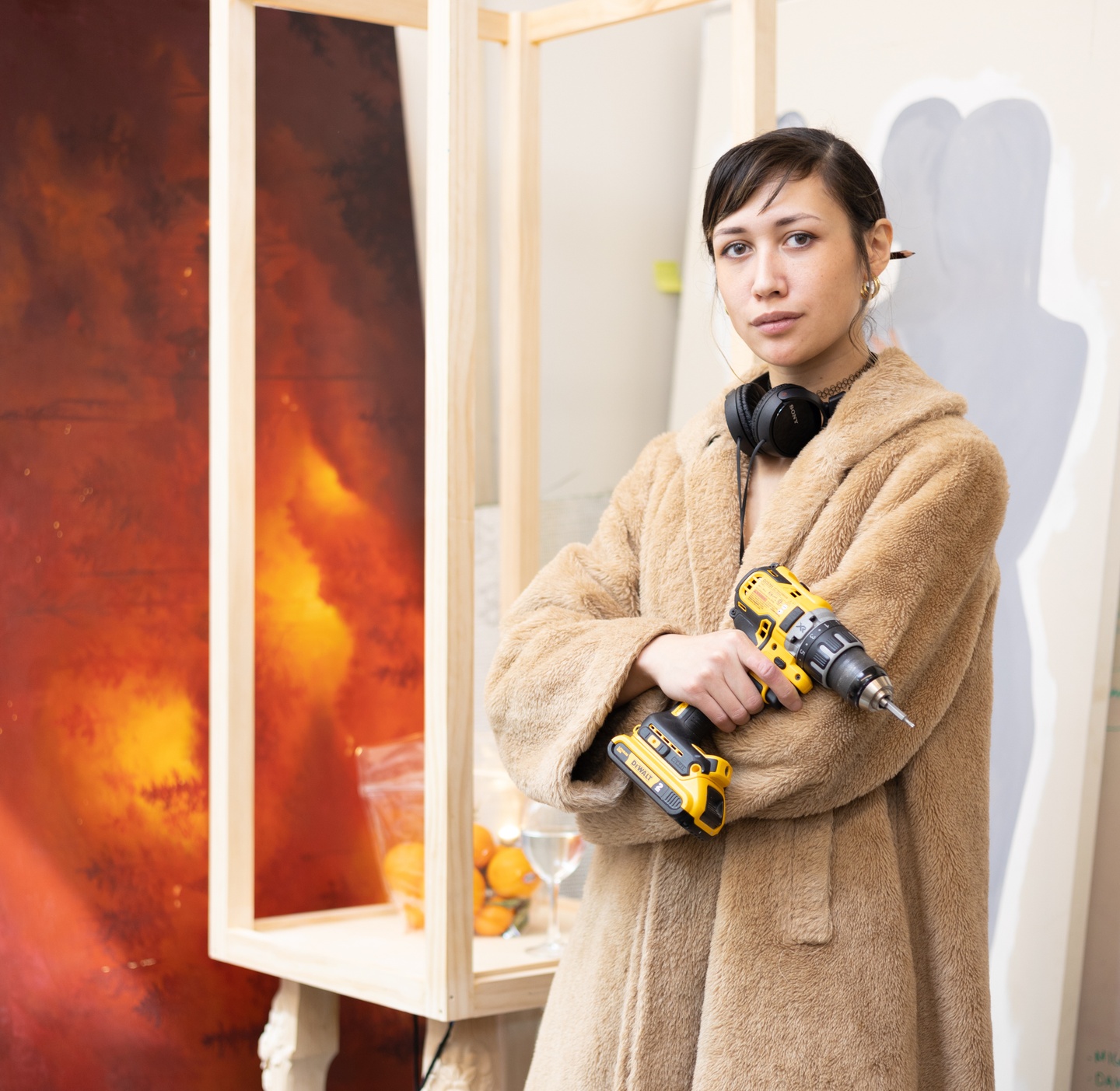Q&A with Samantha Slone
Samantha Slone is a Filipina-American artist whose work is most heavily concerned with global environmentalism in the context of first-world paradigms and biracial intersectionality. Through her current work, she researches and explores human and environmental interconnectivity through a lens of socioeconomic and consumerist systems. She utilizes a visual reference to still lifes of the Dutch Golden Age to frame themes of consumption, capitalism, and colonization in the contemporary realm of climate and social justice.
Samantha Slone, A Phantom and a Fly, 2023, LCD displays, polarizing filters, and wood
Samantha Slone in her studio. (Photo: Caitlin Custer)
Tell us about your project
With this piece, I was thinking of how we engage with people and places through imagery. What does it mean to engage with the world through images of a mass-produced thing?
The idea is to have a landscape represented three different ways: an image, a domesticated version, and a version which barely echoes landscape.
What sort of materials are you using?
My project utilizes a wall-based pillar that has three monitors in it. Then there are mirrors hanging along the wall, reflecting the monitors. This installation is built around the idea that you can only see the image in these mirrors.
I’m also using a variety of materials to think about power, containment, and control. For example, some trim pieces are used to reference a domestic, upper-middle class space.
Does this work have roots in your earlier practice?
I come from a classical painting background. I’ve spent the last 10-15 years doing still lifes. During that time, I’ve brought in the realm of eco-art using hidden motifs to address plastic pollution and other kinds of environmental decay as a memento mori [a reminder that death is inevitable]. My still lifes in the past were a way of starting the conversation within a framework of commodity culture.
I’ve been thinking a lot lately about what it means to see natural spaces as an escape rather than something that are bodies are connected to and immersed in.
What was your path to become an artist like?
I grew up in rural Ohio. Both my parents are factory workers. My mother grew up in deep jungle in the Philippines. When I was young, I asked my mom if we could go camping, because that’s what American kids do. She was like “I grew up camping. It’s not fun.” She grew up in a nipa hut sleeping in mosquito nets.
I was always creative but never understood it as a career path. I thought I’d be some sort of scientist, biologist, chemist, ecologist, zoologist … I went through all of them. I didn’t know what it meant to be an artist when I applied to college, but I taught myself to paint when I was 16 from the internet.
It was such a cultural shock to enter an institution for the first time. I gravitated towards classical painting because there was a part of me that recognized this was some kind of power because it belongs in wealthy, white-collar spaces. That’s a lot of what I’m writing about in my thesis — the aesthetics of power, how we design our spaces, how we attach socio-economic value.
I wanted some of that power for my own life. I was looking for some agency and some power in the world. I came from a family of factory workers where they have no connection to the things they produce every day. There was something about creating something with my hands that felt like I was pulling myself up by my bootstraps.

Samantha Slone in her studio. (Photo: Caitlin Custer)
What do you think about that power now?
My relationship with power and agency has definitely become more complicated. I pursued mastery because it was all that I knew I could do. It was a linear goal. But having an artistic practice is about so much more than mastery. It’s really become less about reaching a specific goal and more about immersing myself in the practice itself. It’s shaped how I see, move through, and engage with the world.
What’s your experience at WashU been like?
My time at WashU has been valuable because it gave me a base for a couple years. Previously, I was at a place where, to survive, I had to make something marketable, and that was just too high stakes for actual artistic growth. So being here was the first time in a long time where I could take risks. It allowed me to free up my thinking and delve into different parts of my research.
I don’t think that freedom ends here. I found a kind of fluidity that is going to be invaluable in whatever comes next.
What do you hope people experience when they see your work?
What I hope to convey with this project is for people to think about the lenses we use to engage with the world — our little phones that give us the illusion of infinite access. I hope the installation gives a sense of being immersed in something or exposed to something that you can’t really comprehend or pin down unless you’re in a very specific place.
I’ve made a lot of paintings over the years, and painting an image has a tendency to be pretty didactic. This piece is a lot more of an experiment. I focused a lot more on the effect than drawing someone to a specific conclusion. I want that moment of confusion and wonder upon entering the space and witnessing this kind of technology — to get people to be very conscious about their bodies in space. That curiosity drives everything I do, and I want to share that.
Samantha Slone reflected on the scope of her practice, time at WashU, and thesis project leading up to the MFA in Visual Art thesis exhibition. This is an edited transcript of Slone’s words as told to Caitlin Custer.



